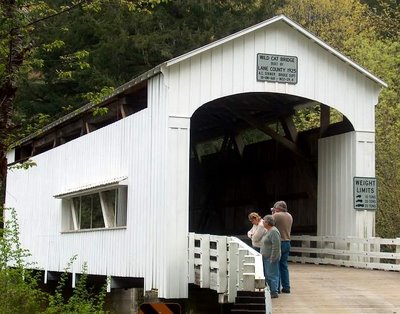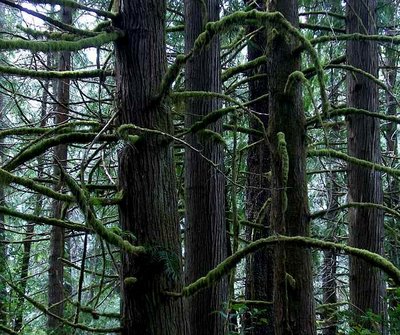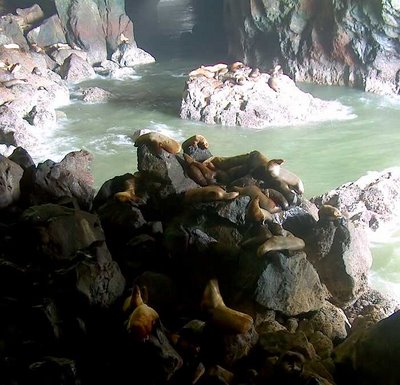We started the day with a drive to the Winchester Dam Fish Ladder on the Umpqua River. The fish viewing facility at Winchester Dam, which was initially upgraded by local residents as part of a volunteer community development project in 1999 and 2000, has proved very popular. As many as 70,000 people come to watch migrating salmon and steelhead ascend the fish ladder and pass by the viewing window each year. There were 56,600 visitors in 2000. Currently, steelhead and chinook salmon are passing over the dam, with the best viewing in the morning hours.

The fish ladder is about 100 feet long and is made up of a series of ascending steps. The fish swim over the dam by jumping into each successive step. To work most efficiently the steps should be longer than they are wide. But the Winchester Dam fish ladder steps are square, which increases the amount of turbulence caused by the water as it flows down the ladder, making it more difficult for the migrating fish to swim through.
"When the water hits the steps, it boils," said ODFW’s Winchester Dam fish counter Fabian Carr. "The fish will jump into the boils and may jump over the wall and end up back in a lower step again. It puts extra stress on the fish." This can result in steelhead and salmon taking as long as five minutes to ascend the fish ladder when they should be able to do it in less than a minute. To remedy the situation, baffles will be installed in the steps to slow and calm the flow of water.

A closer view of the ladder.

Looking through this viewing port you can see the dam and the water running through the ladder.
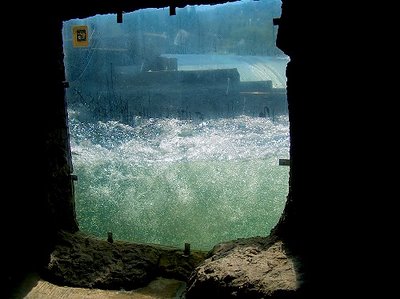
Mmmmm I wonder what they see?

Looks like what Jim calls "Sucker Fish" and I don't think it's sucker as in Tootsie Roll Pop.

The Catostomidae, or sucker family, is closely allied with the minnow family. Suckers are soft-rayed fishes that possess a toothless, protractile mouth with distinctive thick lips. The longnose and white suckers are two of the most common representatives of this family in Michigan's Great Lakes.
Both the white and the longnose sucker are bottom feeding fish and spend most of their time in shallow, warm waters. In bays, estuaries and tributary rivers, both species make their homes in holes and areas around windfalls or other underwater obstructions. However, longnose suckers have been found as deep as 600 feet in Lake Superior.
Although white and longnose suckers both lay their eggs among pebble and gravel beds in lake and river shallows during the spring, longnose suckers spawn several days before white suckers. Sexual maturity arrives at five to nine years of age for the longnose while the white species matures at three to eight years. In addition, white sucker females grow faster, get larger and live longer than males. Maximum life expectancy for white suckers appears to be 17 years; it can be as long as 22-24 years for the longnose. Whites usually grow to be 12-20 inches long, while the longnoses grow to 15-25 inches.
As youngsters under 12 inches in length, suckers are eaten by northern pike, muskellunge, bass, walleyes and burbot. Sucker fry are preyed on by Atlantic Salmon and fish-eating birds. Sea lampreys damage sucker populations in areas where lake trout are scarce. As bottom feeders, both species dine exclusively on aquatic plants, algae, and small invertebrate animals - especially worms and crustaceans. White suckers have been accused of consuming large quantities of eggs from more desirable fish species, but there is no conclusive evidence to support this contention. The longnose sucker is not a serious predator of fish eggs.
Economically, suckers are at present a potentially valuable by underused sport fish. Their bony flesh has a fine, sweet flavor and is often fried in butter, smoked or used in soups and chowders. Commercially, it is often marketed under the name "freshwater mullet." Commercial "deboning" machines have been developed, so minced mullet products may one day be available in your local store. Also, suckers have great value as bait (usually for pike or muskie), and are often fed to sport fish in hatcheries. Theses versatile fish are commanding increasing respect from commercial and sport fishermen alike.
The white sucker goes by a number of other names, like common sucker, coarse-scaled sucker, brook sucker, gray sucker, mud sucker, sucker, mullet, black mullet, slender sucker, June sucker and white horse.

Just a quick shot of the Umpqua River and the "Old Bridge" pilings still standing in the river

Here is the new bridge over the Umpqua. The bridge is interstate 5.


It is always a beautiful sight and from the sounds of it it's also sometimes a dangerous place to be.

I took a shot through one of the drainage ports in the wall at the lookout.
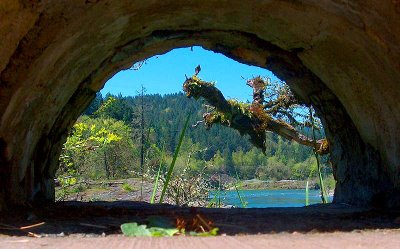
Doreen saw something unusual in this tree - looked like a snake - but it was only a piece of rope. It even looks real in this picture.

Jim, having taken several pictures and Doreen on their way back to the mini-musemobile.

I don't remember the names of the waysides we stopped along the drive but this was the first. We hada great picinc lunch and Jim and Doreen walked a trail to some falls. See if you can find the stone face complete with a Bob Marley hairdo.

Sharyn went ot follow and took the camera and got this great shot of what we think was a Jack-in-the-Pulpit but I'm not sure. This was a rare beauty.

Just the peak of a rock formation on the drive.

And another no names to attach to them.

Clear water - Wait! is that a fish or a rock?

Sharyn and Doreen enjoyed the sunny day.

Jim and I enjoyed the sights and phorography especially of the running water.

and more of a similar nature.

Then came Diamond Lake and Mount Bailey....

...and the cute pine tree cutouts on the lodge....

... and the assembled cleanup tools for getting the new season ready to go.
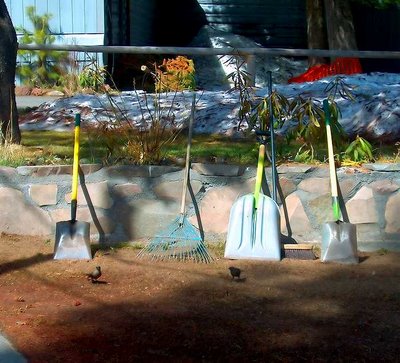
Diamond Lake is a great place for both Summer and winter fun.


Right now they are getting ready for the thaw at the boat pier.

And this young man is trying to thaw the ice with a yard water sprinkler.
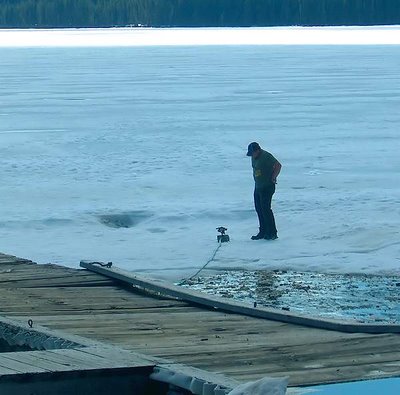
Mount Thielsen looks a lot like.........

.......

On the way back just out of Roseburg is a hill with a barn and the perfect pastoral look.

There was even some beauty left in the parking lot of Ray's Place the local food store.

Quote of the Day
"We found Matisse living in a small house, with a magnificent, sweeping view beyond his vegetable garden. In one room there was a cage with a lot of fluttering birds. The place was covered with paintings, most of them obviously new ones. I marveled at his production and I asked him, "What is your inspiration? "I grow artichokes, he said. His eyes smiled at my surprise and he went on to explain: "Every morning I go into the garden and watch these plants. I see the play of light and shade on the leaves and I discover new combinations of colors and fantastic patterns. I study them. They inspire me. Then I go back to the studio and paint." ~ Andre Kostelanetz
US pianist, conductor, b. Russia, focused on semiclassical & simplified classical works


